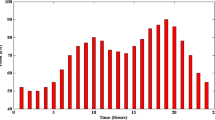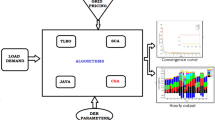Abstract
This study investigates the optimal scheduling of a grid-connected microgrid incorporating an incentive-based demand response program (IBDRP) at the customer side to reduce electricity consumption. A mixture of renewable and non-renewable energy sources was deployed in the microgrid. This comprises wind energy, solar energy and power generating units (PGUs). A multi-objective model was formulated which seeks to simultaneously minimize the annual cost of electricity production, minimize the carbon dioxide emission and maximize the customers’ participation in the IBDRP, to increase the customer benefit that comes with the program. The Advanced Interactive Multidimensional Modeling System (AIMMS) software was used to solve the formulated multi-objective optimization model. The simulation results obtained show the applicability of the model.
Access provided by Autonomous University of Puebla. Download conference paper PDF
Similar content being viewed by others
1 Introduction
Over the time electricity has become one of the greatest vital forms of amenities to man. However, modeling and planning of quantity of electricity consumed have been a major concern to both researchers and industry [1]. The balancing between the power generation and consumption is crucial for the smooth running of the power grids. Any disparity between power supply and demand would increase costs to both the load serving entity and consumers which may damage the entire grid. Thus, the electricity industry is undergoing a time of speedy and unprecedented transformation in the deployment of renewable energy generation technologies. Since 2012, renewable sources have generated more than half of the new energy generation capacity worldwide. In 2016, total renewable energy generation that was accounted for exceeded 2000 GW, doubling the quantity in the space of nine years [2].
Today’s microgrids consist of a combination of renewable and non-renewable sources of power generation to meet the ever-growing electricity demand. To this end, microgrids comprise small distributed energy resources (DER) located close to the consumers. This comes with advantages such as the ability to operate in either the grid-connected or island mode of operation to enhance the supply reliability. Additionally, it also improves the network performance resulting in loss reduction, voltage control and reduced congestion. Demand response (DR) is a useful tool in the electricity market. They are activities on the consumers’ side, which helps to reduce the customer’s electricity usage while maintaining the efficiency and reliability of the grid. They are usually divided into two broad groups: incentive-based demand response program (IBDRP) and price-based demand response program (PBDRP). The first type is typically formulated as a contractual agreement with consumers, where they get incentives in monetary value when they cut down their electricity usage, while the latter depends solely on the dynamic electricity price, which can be either peak or off-peak. Prices tend to be higher at peak periods to encourage energy curtailing and low at off-peak hours [3]. Over the years, there have been many researches in the area of dispatching and deployment of DER in the microgrids incorporating DR to curtail electricity at the customer’s side [4]. Reference [5] worked on day-ahead scheduling for commercial buildings combining time of use (ToU) and demand pricing (DP) to plan the demand response program (DRP) with the goal of minimizing monthly electricity charge, while Asadinejad and Tomsovic [6] proposed a model deploying both ToU and IBDRP plans based on the demand price elasticity to design an optimal structure for achieving cost reduction and maximizing customer acceptance level of the DRP. Also, the work done in [7] modeled the responsive load behavioral model with linear and nonlinear modeling for the IBDR and PBDR programs. In [8], optimization of a home-based energy management controller integrating various categories of loads which could be curtailable, deferrable and non-deferrable appliances and sought to simultaneously minimize customer’s electricity bill and the day-to-day capacity of energy curtailed. The contributions of this paper include:
-
1.
Investigate an incentive demand response program with renewables to minimize annual cost and maximize the profit of customer participation.
-
2.
Evaluate the impact of an IBDRP on the operational schedule of the microgrid and by extension on the cost metrics.
The rest of the paper is organized as follows: Sect. 2 presents the system modeling and formulations, Sect. 3 details the verified results, and Sect. 4 gives the conclusion and future works.
2 Methods
2.1 Microgrid Model
The sources of power deployed in a microgrid consist of both renewable and non-renewable sources, which comprises: 1 PV, 1 wind, 3 PGUs, a grid connection and 10 willing customers. The objective function is to minimize the annual cost of electricity production and carbon dioxide emission. The mathematical formulation is presented as follows:
Subject to the following constraints:
where
The following is a brief description of the constraints:
Equation (2): The PGU’s output (i) at time (t) must be less or equal to the maximum capacity of the PGU.
Equation (3): This constraint is referred to as the energy balance constraint, which means the output from the PGUs (\(yp_{i,t}\)), the energy from the grid \((E_{{{\text{grid}}_{t} }} )\), output from the wind (\(yw_{t}\)) and output from PV (\(ypv_{t}\)) must be equal to the total load.
Equation (4): The PV output at time (t) must be less or equal to the forecast solar power at time (t).
Equation (5): The wind output at time (t) must be less or equal to the forecast wind power at time (t).
2.2 The Incentive-Based Demand Response Model
The aim of demand-side management program, which demand response falls under, is to regulate the demand for electricity amongst consumers by reducing load and improving system reliability. Clearly, demand response contract formulations give incentives to customers who were willing to engage in the load disruption with payments [9]. The demand response model in the study involved ten customers who are ready to participate in the contract and willing to declare the amount of load they want to reduce in return for incentive.
The mathematical formulation seeks to maximize the total customer benefit and is presented below:
Subject to the following constraint:
where
The following is a brief description of the constraint:
Equation (10): The quantity of load reduction of a customer (j) in time (t) multiplied by the customer participation (j) at time (t) must be greater or equal to critical load.
2.3 Combined Mathematical Model
The combined mathematical model consists of mathematical models representing both the microgrid and the incentive-based demand response program. The multi-objective function and its constraints are given below:
Subject to the following constraints:
3 Numerical Simulations, Results and Discussion
To verify the developed model in Eqs. (16)–(22), we use a case study of 1 PV, 1 wind, 3 PGUs and 10 willing customers. The Advanced Interactive Multidimensional Modeling System (AIMMS) software [10, 11] was used to build and solve the multi-objective mathematical model using outer approximation algorithm (OAA) [12]. The data used in this work is gotten from a site from Harare in Zimbabwe [13]. The variables to be determined are as follows.
\(ypv_{t}\)—the hourly output of PV generator at time t, \(yp_{i,t}\)—hourly output of the power generating units (i) in time (t), \(E_{{{\text{grid}}_{t} }}\)—energy bought from the grid at time t, \(yw_{t}\)—hourly output of wind generator at time t, \({\text{CPART}}_{j,t}\)—the variable indicator that shows the customer participation in the demand and response contract and \({\text{PLR}}_{j,t }\)—the determined price of the quantity of energy reduced by the customers.
Table 1 shows the customer load curtailed and corresponding incentive, while Table 2 presents the hourly output from the various microgrid sources.
From Table 1, it is clear that the higher the quantity of load reduced the higher the customer incentive. For example, customer 1 was willing to reduce 10 kW at hour 12, which gives payment of $5, as against customer 10 who was willing to reduce 40 kW at hour 8 whose payment will be $20, thus higher than the payment of customer 1.
From Table 2, it can be observed that the output from the PV only starts generating from 8 a.m. to 6 p.m. due to the weather conditions. The output from wind dispatches as appropriate without any form of hindrances, while the three PGUs also dispatch effectively.
4 Conclusions
This work investigates the energy management of a microgrid incorporating the incentive-based demand response program. A multi-objective optimization model is proposed to determine the annual cost of electricity production, which minimizes the carbon dioxide emission and maximizes the customers’ participation in the program. The Advanced Interactive Multidimensional Modeling System (AIMMS) software was used to solve the proposed model. Furthermore, obtained results show that incorporating demand response program could be helpful at both the supply and demand sides of the microgrid. Also, it was observed that the customers’ participation in the program was maximized which is one of the objective functions of the model.
References
Nwulu NI, Agboola OP (2012) Modelling and predicting electricity consumption using artificial neural networks. In: 2012 11th International conference on environment and electrical engineering EEEIC—conference proceedings 2012, pp 1059–1063
IRENA (2018) Renewable power generation costs in 2017
Sadati SMB, Moshtagh J, Shafie-khah M, Catalão JPS (2018) Smart distribution system operational scheduling considering electric vehicle parking lot and demand response programs. Electr Power Syst Res 160:404–418
Fahrioglu M, Nwulu NI (2012) Investigating a ranking of loads in avoiding potential power system outages. J Electr Rev (Przeglad Elektrotechniczny), Warsaw, Poland 88(11a):239–242
Zhu K, Lu N, Zheng J, Sun G, Mei F (2019) Optimal day-ahead scheduling for commercial building-level consumers under TOU and demand pricing plan. Electr Power Syst Res 173(August 2018):240–250
Asadinejad A, Tomsovic K (2017) Optimal use of incentive and price based demand response to reduce costs and price volatility. Electr Power Syst Res 144:215–223
Rahmani-Andebili M (2016) Modeling nonlinear incentive-based and price-based demand response programs and implementing on real power markets. Electr Power Syst Res 132:115–124
Soares A, Gomes Á, Antunes CH (2014) Categorization of residential electricity consumption as a basis for the assessment of the impacts of demand response actions. Renew Sustain Energy Rev 30
Nwulu NI, Fahrioglu M (2011) A neural network model for optimal demand management contract design. In: 2011 10th International conference on environment and electrical engineering EEEIC.EU 2011—conference proceedings, pp 1–4
Gbadamosi S, Nwulu NI, Sun Y (2018) Multi-objective optimization for composite generation and transmission expansion planning considering offshore wind power and feed in tariffs. IET Renew Power Gener 12(14):1687–1697
Damisa U, Nwulu NI, Sun Y (2018) Microgrid energy and reserve management incorporating prosumer behind the-meter resources. IET Renew Power Gener 12(8):910–919
Kronqvist J, Bernal DE, Lundell A, Grossmann IE (2018) A review and comparison of solvers for convex MINLP, no. 0123456789. Springer, US
Nwulu NI, Xia X (2017) Optimal dispatch for a microgrid incorporating renewables and demand response. Renew Energy 101:16–28
Acknowledgements
The first author would like to thank the University Research Committee (URC) at the University of Johannesburg for the Study Scholarship Award.
Author information
Authors and Affiliations
Corresponding author
Editor information
Editors and Affiliations
Rights and permissions
Copyright information
© 2020 Springer Nature Singapore Pte Ltd.
About this paper
Cite this paper
Olorunfemi, T.R., Nwulu, N. (2020). Optimal Grid-Connected Microgrid Scheduling Incorporating an Incentive-Based Demand Response Program. In: Emamian, S.S., Awang, M., Yusof, F. (eds) Advances in Manufacturing Engineering. Lecture Notes in Mechanical Engineering. Springer, Singapore. https://doi.org/10.1007/978-981-15-5753-8_56
Download citation
DOI: https://doi.org/10.1007/978-981-15-5753-8_56
Published:
Publisher Name: Springer, Singapore
Print ISBN: 978-981-15-5752-1
Online ISBN: 978-981-15-5753-8
eBook Packages: EngineeringEngineering (R0)




